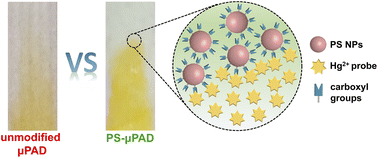Clarity improvement of the discoloration boundary and detection of Hg2+ ions by using a polystyrene nanoparticle-modified paper-based microdevice†
Abstract
Distance-based microfluidic paper-based analytical devices (μPADs) can be used to calculate the analyte content by reading the length of the discolored area in the channel. A blurred discoloration boundary is difficult to distinguish, resulting in reading errors. In this study, we constructed a μPAD modified with carboxyl-containing polystyrene nanoparticles (PS-μPAD) to improve the discoloration-boundary clarity. The filling of the pores of the fibers with the deposited polystyrene nanoparticles (PS NPs) caused a decrease in the paper porosity, resulting in a flow delay. Meanwhile, the carboxyl groups carried by PS NPs were able to form hydrogen bonds with hydroxyl-containing compounds FLPI, a Hg2+ probe, and the two factors acted synergistically to fix the FLPI to react in situ, raising the discoloration-boundary clarity. Compared with the unmodified μPAD, the detection of Hg2+ ions using the PS-μPAD still had a good linear relationship. Importantly, the color-depth difference inside and outside the discoloration boundary improved by about four times and showed excellent reproducibility in different populations. The method was simple and easy to expand, thereby providing an idea for more widespread application of distance-based μPADs.



 Please wait while we load your content...
Please wait while we load your content...